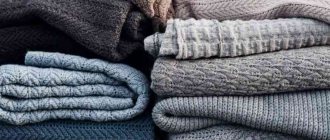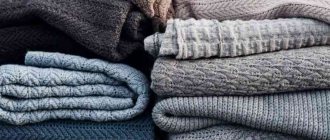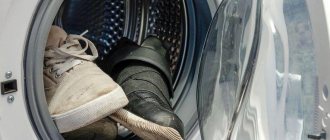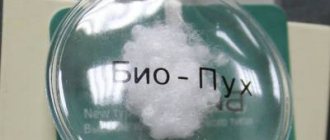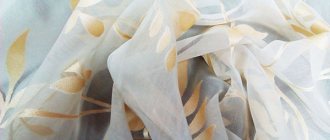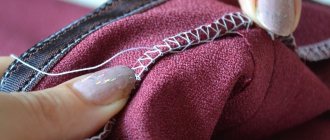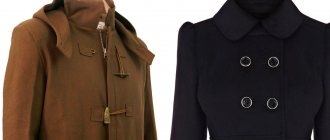How to wash a coat in a washing machine
First of all, find out the composition of the fabric of your coat. Only polyester is safe to machine wash. All other materials run the risk of irreversibly losing their appearance during machine washing.
- In the machine settings, set the mode for delicate fabrics: temperature 40 degrees, “delicate wash” or “hand wash”, turn off the spin cycle.
- It is recommended to place the coat in a special washing bag.
- Fasten all fasteners except buttons.
- Pour washing conditioner into the special compartment.
- After finishing washing, leave the coat to dry in a well-ventilated place.
Unforeseen circumstances or seasonal care make you wonder whether you can wash your coat at home. The question arises: is it possible to wash it at all? It is possible, but the method: manual, machine or dry cleaning directly depends on the composition.
It is allowed to wash coats in an automatic washing machine if they are made from the following materials:
- acrylic (PAN);
- Lycra (LY);
- modified acrylic (MA);
- nylon (NY);
- polyamide(PA);
- polyurethane fiber (PU);
- polyester (PL);
- elastane (EL).
Delicate dry cleaning is allowed for any type. Washing coats in an automatic machine is not possible for all products. If the fabric type is mixed, you should pay attention to the presence of natural fibers. Plant and animal components complicate the care of the coat.
Please check the label before washing. In the picture on the left - the coat can be washed on a delicate cycle at a temperature of no more than 40 ° C, on the right - only delicate dry cleaning is allowed.
It will not be possible to wash a coat at home using an automatic machine if it consists of 100% natural fibers, for example, cashmere (WS 100%), drape, wool. Neither delicate mode, nor minimum temperatures, nor special means will help. This is because, in addition to natural fibers, a cashmere coat has a special impregnation.
Dublerin is responsible for maintaining its shape, but upon contact with water and temperatures it is washed out. The appearance of a washed coat changes dramatically: the hems and collar are rolled up, the fabric looks wrinkled.
Natural fibers combined with synthetic ones give a mixed composition. If the synthetic content is about 50%, then feel free to start washing.
How to wash a coat in a washing machine.
If the label located on the product and the composition are machine washable, feel free to proceed. Don’t forget about the general washing rules: preparation, mode, temperature, spin.
Preparing for washing
Elements that may harm the appearance of the coat when washed should be removed. If they don’t come unfastened, then they unfasten if possible. Elements for removal include: three-dimensional decorations, jewelry, metal parts, collars, cuffs. The buttons are fastened.
Preparation involves not only removing cuffs and fur collars, but also cleaning the material. Pre-cleaning involves removing aggressive contaminants: dust, surface stains, soil and sand. Animal hair and threads should also be removed from the coat material.
For cleaning, you should use a special brush with medium-hard bristles or a roller to comb the product along the seams. If there are none, use a dish sponge with a rough coating. The product must be cleaned first with dry and then with soft, wet cleaning.
It is convenient to carry out the procedure on a horizontal surface, which will further avoid deformation of the product.
List of available modes for washing coats:
- For all types of fabrics, even finicky ones: delicate; manual; wool.
- For polyester, padding polyester, membrane: synthetic; membrane.
- For coats filled with down and feathers: a duvet.
The correct washing mode is the key to the safety of the product. Information about acceptable modes can also be found on the label.
The range from 30 to 40 degrees is typical for many fabrics, both artificial and natural. These include wool coats with the addition of gabardine and vigoni.
A level of up to 30 degrees will have to be maintained if the coat is made of tweed, suede, polyester, or neoprene.
No twisting, just gentle hand squeezing. Automatic spinning is not recommended for any type of fabric or filling. Application is fraught with deformation for the material and breaking into lumps for padding polyester.
The spinning and drying cycles should take place outside the drum. Natural removal of moisture by draining water is an ideal spinning method. To speed up the process, you can blot your coat with dry towels.
The exception is products made from holofiber. They can be dried at 1 thousand revolutions.
Is it machine washable or does it require dry cleaning?
The main question that arises when it comes to cleaning clothes made from drape is whether the product can be washed in a washing machine, or whether it is worth taking the coat to the dry cleaner.
To answer this question, you should pay attention to the following nuances:
Examine the label attached to the product.
It will give answers to many questions, ranging from the percentage of natural and synthetic components in the fabric, and ending with recommendations for care and cleaning (washing, drying, ironing). It should be taken into account that the higher the number of natural components in the fabric, the more careful care the coat requires, and it should not be washed in an automatic machine.- It is necessary to pay special attention to the color of the product. If the coat is not one color, then it is better to turn to other cleaning methods than machine washing.
- If a drape coat has various decorative elements (embroidery, rhinestones, beads), then you should not resort to cleaning in a washing machine, because this can greatly spoil the appearance of the jewelry.
Thus, cleaning a drape coat can be done at home in a washing machine, if this does not contradict the data indicated on the product label.
Otherwise, it is better not to take risks and entrust your coat to specialists, or resort to other cleaning methods.
Preparation
Before washing, it is advisable to perform a few simple steps:
- Unfasten all overhead items (collar, cuffs, etc.). If the collar is sewn on, carefully rip it off.
- If necessary, make minor repairs to clothing (sew on buttons, sew up seams).
- Carefully inspect the item of clothing to identify stains that are difficult to remove. If stains are found, they need to be removed.
- Empty pockets, fasten zippers or buttons.
- Find the label that contains washing recommendations and study them carefully.
You need to prepare for cleaning your outerwear in advance and take it more than responsibly! The final result depends on the preliminary work, which means that it is in everyone’s interests to do everything extremely carefully, clearly, and correctly:
- First of all, we look for an icon that prohibits washing, but if it is not found, we take a risk and go for broke!
- Before you begin, empty all pockets, check for glued parts, be prepared for them to fall off and come off.
- Do a preliminary test of using detergent on the wrong side or in an inconspicuous place, look at the result.
- If you decide to use an automatic machine, think in advance about the loading weight ratio and the maximum weight capacity in your drum.
Before you start, empty all pockets, check for glued parts, be prepared for them to fall off and come off
How to dry properly
To get rid of excess water, you can lay your coat in the bathtub, apply pressure with your palm and run it from the collar to the bottom of the item, pushing out the water. A large terry towel will help dry the item of clothing a little more. You need to wrap the item and leave it for a while so that the towel absorbs the moisture. Next, take a towel or other highly absorbent fabric, on which the coat is placed to dry. If possible, the drying room should be well ventilated. The sun's rays are also an undesirable phenomenon, as are heating devices.
How to wash a coat - choice of products
Regardless of whether a drape coat can be washed in a washing machine or is only allowed to be washed by hand, it is recommended to use detergents that rinse well and do not leave streaks on clothes. The choice should be made on liquid products such as gels and capsules. It is advisable to choose products in accordance with the color of things: for colored, for white, for black.
An important feature when washing an autumn coat is that the product is classified as delicate. It is demi-season coats that are most often created from natural fabrics that require careful washing. Choose liquid, gel or capsule detergents.
A winter coat may contain down or feather, padding polyester or holofiber as insulation. Based on this, the available funds are distributed:
- padding polyester, holofiber – liquid, gel products, capsules;
- down and feathers – specialized liquid products for down jackets, capsules.
- Price - 15 pieces of Tide - from 170 to 304 rubles and 13 pieces from Ariel - 190-365. The average cost of a capsule varies in the range of 12.8–23.8.
- Description - Available in capsule format. Suitable for machine wash only. The product cleanses, removes stains and enhances color.
- Purpose: You can wash delicate fabrics. Suitable for any type of material.
We invite you to check out Home> Popular> Home and Garden>»bra washing bag»10,673 results
Pros/cons - despite the stated ability to whiten and remove stains, the capsules do not contain chlorine or aggressive substances, and are therefore suitable for washing coats. The disadvantages include the need for additional use of air conditioning.
- Price - for 1 liter you will have to pay from 185 to 370 rubles.
- Description - Available in gel format, which is excellent for delicate washing, both by machine and by hand. There is both a universal gel and gels divided by color spectrum - for white, black, colored.
- Purpose - suitable for any type of product and material, including coats made of delicate fabric. Exception: winter coats filled with down and feathers.
Pros/cons - apart from the wide range in price (from low to moderate), can only be described on the positive side. Prevents the formation of pellets. Does not contain chlorine, phosphates, dyes, or aggressive chemicals. Washable even at low temperatures. Rinses out perfectly.
Gels BiMax, Tide, Persil, Ariel also deserve attention. Their characteristics, description and purpose are identical. They are great for washing coats of any type thanks to the gel base. Tide has the lowest price - you will have to pay 172 rubles per liter. BiMax has an inflated price tag (for 1 liter - 270 rubles), while having a number of disadvantages, unlike the products under consideration - it has an unpleasant odor.
You should make a choice based on color and type of material. For color and black, you cannot use the “For white” marking to avoid color washing out.
- Price - for 750 ml - 107–120 rubles.
- Description - the gel formula allows it to dissolve in water without a trace.
- Purpose: Suitable for woolen and delicate fabrics.
Pros/cons - rinses well both after machine and hand washing. Prevents the formation of pellets. Does not contain bleach or phosphates, making it suitable for colored and white materials. The downside is that it has a fragrance, but it is unobtrusive.
- Price - from 399 to 479 for 250 ml.
- Description - a liquid gel product specially designed for winter coats made of down and feathers.
- Purpose - suitable for any type of washing.
Pros/Cons - Maintains color vibrancy. The filler does not roll, does not fall off, and retains its thermal insulation and air tightness properties. A significant disadvantage is that it does not always fully cope with contamination.
The unsuitability of products containing chlorine and active oxygen for cleaning coats has already been indicated. Next up are stain removers. The Dr. line has proven itself well. Beckmann.
- Price - from 113 to 197 per 50 ml - depending on the type of stain.
- Description - for each type of stain there is a different stain remover option (fats and sauces, fruits and drinks, blood and protein stains, etc.)
- Purpose - suitable for washing woolen and delicate fabrics by machine or hand washing.
Pros/cons - the product will help you deal with stains even on items that are not recommended for washing (cleaning only). They have a directional effect. Does not contain fragrances or phosphates.
Washing powders, bleaches, stain removers with chlorine or active oxygen should not be used. Therefore, when choosing from the line, remember that products containing active oxygen are not recommended for coats made of natural fabrics.
How to stroke?
Before ironing your coat, read the label information. Set the iron to the desired temperature. When ironing a drape coat, it is best to use the steam function. If your device does not provide it, then it can be replaced by ironing the product through a damp natural fabric, for example, chintz or gauze, folded in several layers.
Try to clean your drape coat every time before storing it after the end of the cold season. This will help you prevent damage to the product by moths. To repel moths, you can additionally use special means.
We hope that our tips will help you cope with such a task as washing a drape coat. Try to follow the directions on the product label so that the item will last longer and you won’t have to throw it away after one or two seasons.
For more tips on how to properly care for your coat, watch the following video.
Features when washing coats made of different materials
A coat is a type of winter and demi-season outerwear with a long cut. Buying such a thing requires delicate and careful care.
https://www.youtube.com/watch?v=4XOEysYlZJw
But what to do if contamination cannot be avoided and how to remove it:
- The theory says that washing outerwear, in particular coats, in a semi-automatic machine, much less an automatic machine, is completely unacceptable, and is punishable by a significant deterioration in the appearance and quality of the washed product.
- The practice and personal experience of housewives shows, albeit very incredible, evidence of the opposite statement.
- Before wondering whether it is possible or impossible, it is worth understanding what exactly to wash. It all depends on the fabric, texture, tailoring, quality, type of dyes and quality of fabric dyeing and much more.
- Here is one of the secrets of professionals for determining the quality of coloring: you just need to soak an inconspicuous area of the coat in warm water for 1 hour and see what happens next. Has the matter faded and faded? Has the water turned a bright, characteristic color? This means that the removal of contaminants from this item is postponed indefinitely.
If you wash your coat correctly, negative consequences can be avoided. Washing requirements vary depending on the type of fabric.
Features of washing natural fabrics:
- Drap. Use wet washing as a last resort if dry methods do not work. Hand washing in water up to 30 degrees is recommended, but machine washing is also possible with restrictions, read the link for more details.
- Tweed. To clean, simply remove dirt with a brush. If the stain is wet, dry and brush off. If the dirt is stubborn, dissolve liquid detergent in water and blot the affected area. After 5 minutes, treat with a sponge. Washing is not recommended; only hand washing is available at a temperature of no more than 30 °C.
- Vigogne. Despite the natural composition (camel hair), vigons can be washed in a machine.
- Wool. Hand washing is recommended only without twisting or rubbing. Read more about washing here.
- Cashmere. You can wash a cashmere coat with impurities in the machine, but the label must contain information about the availability of the procedure.
- Leather. Long water procedures are not recommended, but hand washing is available in the most delicate mode. The product should be turned inside out and worked directly with this area.
- Suede leather. Do not soak, rub or twist. Natural, unlike artificial, can be washed by hand. For artificial ones, only local cleaning with mild detergents is indicated.
Features of washing artificial fabrics:
- Polyester. You can wash a polyester coat using any method, but only in the delicate or synthetic mode at a temperature of 30–40 degrees. Should be washed inside out.
- Neoprene. Requires washing in two stages - first the wrong side, then the front side.
- Holofiber coat. Easily machine washable, but at a temperature not exceeding 40 degrees.
- Coat on padding polyester. The most gentle machine or hand wash with gentle detergents in water up to 30 °C.
To prevent the padding polyester coat from bunching up, place special or regular tennis balls in the drum.
It will not be possible to put a drape coat in order without drying it. After washing, the product made from drape fabric must be allowed to drain.
We suggest you read: How to effectively and quickly wash a burnt pan
On hangers, the product will dry quickly and there will be no wrinkles on it. But you shouldn’t hang up your coat immediately after washing, because when wet its weight is significant. You should not dry it near heat sources, because it may shrink.
If you dry it properly, there will be no need to iron it. You can use a steamer and the product is ready for further use.
There are several recommendations on how to wash a coat in a washing machine if it is a demi-season or winter coat. Autumn and spring coats are light, with a minimum number of layers, not so dense, made of soft fabrics. A coat for cold weather has three layers: a dense top layer that protects from the cold, insulation and a lining.
Demi-season coat
Natural wool, drape, cashmere, cotton require more attention. When washing them, be sure to follow a delicate cycle without spinning and a low temperature.
Things made of polyester are not so capricious. They wash easily, dry quickly, and do not lose their shape. True, it also has its own characteristics. If the water is too hot, wrinkles will form that are difficult to get rid of. The best temperature is 40 degrees. Dry the polyester coat on hangers.
Winter coat
| Material | Washing type | Washing mode | Temperature | Facilities | Drying |
| Sintepon, holofiber | Machine | "Synthetics" "Manual" "Delicate" | 30-40 degrees | Liquid products, gels | First horizontally, then on hangers |
| Feather | Machine | "Delicate" | Less than 30 degrees | Special liquid detergents for washing down jackets | Dry in a ventilated area, away from other things. |
It must be remembered that during washing the insulation may clump into clumps. Plastic balls with spikes will save you from such trouble, and some even prefer tennis balls. They are simply placed in the drum of the machine. Three balls are enough. They “break” the filler and prevent it from clumping.
Advice. The down jacket will please its owner with a refreshed look if first, before the main wash, you simply rinse it twice without powder in the machine (this way you can remove excess dust from the down), and after washing, rinse it three more times (this is how the detergent will be washed out best).
When drying coats that contain insulation, there are some peculiarities. First you need to lay the wet product horizontally, and when the coat dries a little, you can hang it on hangers. The explanation is simple: if you immediately hang a coat with filling on a hanger, then the weight will cause the filling to fall down.
By the way, the down jacket should also be dried correctly. There must be air circulation in the room where it is dried. Such clothes should not be dried close to other things. For quick drying, a place close to the radiator is suitable (but, of course, you can’t hang it on it!).
How to dry at home?
Drying a drape coat after washing at home is difficult - that’s a fact. Prepare a stack of thick terry towels - all will come in handy. When the water has drained, lay the coat on a towel and roll it up. Dry thoroughly, leave for 10 minutes. When the moisture is absorbed, unwrap and replace the towel. Continue soaking until the coat is damp (not wet).
Now lay a new dry towel on a flat horizontal surface and place the product on it. Straighten it well, smooth it out, make sure it is not warped anywhere. Remember in what position it dries, and it will remain in this position afterwards.
At home, the coat is dried in a ventilated room, making sure that the sun's rays do not fall on it. The substrate is often changed, and the product itself is regularly turned over.
Machine washing
First you need to generally understand whether the item can be washed. A tag with special icons will help here, indicating how to clean the product: different fabrics are washed in different ways. Crossed out images of a washing machine or basin prohibit washing. Suitable for dry cleaning only.
If washing is allowed, then you need to prepare for the process. Before loading into the machine, you must follow these rules:
- empty your pockets;
- buttons, locks, buttons to fasten;
- Remove metal parts and decorations (otherwise rust may appear);
- unfasten the fur, otherwise it will fall off;
- Turn the coat inside out.
Washing bag
- It is advisable to use a laundry bag. The clothes are turned inside out, placed in a bag and placed in the washing machine.
- Liquid detergent is poured into the washing powder compartment or into the drum, depending on the manufacturer's recommendations. You should avoid using conditioners and rinses.
- A gentle washing mode is selected, such as “manual”, “delicate” and the like. The “pre-wash” or “soak” mode is not used.
- Spinning in the washing machine will damage the clothes, so this function is not used.
- No additional features apply.
Can a drape coat shrink or stretch when washed?
A drape coat containing wool requires careful care. Errors during washing can lead to the product losing its original shape. The coat may shrink. For such cases, manufacturers have provided a gentle hand wash mode at a minimum temperature.
Or, on the contrary, it will stretch, which also will not make your favorite thing presentable. We wash on a gentle cycle with the exception of spin, or use it at minimum speed.
If you machine wash a wool coat, be sure to select a delicate program at an acceptable temperature. It does not have a spin function, which causes the wool to become deformed.
How to properly wash a drape coat
Washing by hand is considered more gentle than washing by machine. To wash by hand, you must:
- Fill the bathtub with slightly warm water about thirty degrees.
- Pour in the detergent and stir thoroughly.
- Place a piece of clothing into the diluted solution.
- If heavily soiled, leave the item soaked for a quarter of an hour.
- Use a soft brush and use minimal force to clean the product. Pay special attention to cuffs, collar and pockets.
- The item must be rinsed thoroughly. The water from the bath is drained and refilled. This action is repeated several times until the water is clean (two to three times).
- No need to squeeze.
For cashmere and drape coats, hand wash only is available. Machine washing, even in delicate or hand mode, can lead to deformation of the fabric and change in appearance.
Principles for washing coats by hand:
- The cleaning solution should not be highly concentrated to prevent streaking.
- Choice of method: locally or totally. If the coat has glued parts, like drape, or a special application, as is the case with cashmere, then we keep washing at home to a minimum. It is better to act locally and at the same time gently.
- Maintaining temperature. For a drape coat, the maximum allowable temperature is 30–40 degrees. The rule also applies to cashmere products.
After checking all the details, from the product to the temperature, start washing:
- The procedure is convenient to carry out in a bathtub or large basin.
- Dilute the detergent in warm water.
- The coat is immersed in water.
- Contaminants are cleaned carefully. Without aggressive influence, twisting, pressing using a sponge or soft brush. Ideally, holding the product by the shoulders, make pendulum movements in the water.
- For best results, leave the coat in the water for 15 minutes.
- After finishing washing, change the water several times to rinse the detergent out of the fibers without any residue.
- Dry the product, following the rules for working with coats: is it permissible to spin (in the case of cashmere and drape, no), how to dry vertically or horizontally (for drape and cashmere, only horizontal drying).
But did you know that it consists of several layers of fabric, with the addition of wool and linen threads. In addition, cotton is added to the material, due to which the drape is worn for so long and remains in its original form.
Wash by hand
A drape coat can also be washed in a washing machine, but if you do not want to risk an expensive item, it is better to give preference to hand washing.
- First you need to check the contents of the pockets and remove all overhead or removable elements.
- A large bowl will be a suitable container for washing. To do this, pour water at room temperature and add detergent.
- If your outerwear is very dirty, then first let it sit in soapy water for about thirty minutes, after which we begin to wash it with a brush.
- If the coat is quite clean, then you don’t need to soak it, but just rub it a little with a brush.
- After this, the coat must be rinsed several times until the water becomes completely clear.
- The product does not require any spinning! Hang on a hanger so that water flows over the bathtub.
- You can also place the coat in a towel to absorb excess water, and then hang it on a hanger to dry.
We suggest you familiarize yourself with the function of draining in a washing machine
If you still decide to give preference to machine washing, then first you need to study everything that is written on the label. This is where you can find information on how best to wash the product. If the washing machine symbol is not crossed out on the label, then this washing method is suitable for this product.
Use a delicate detergent. Such detergents are often in liquid form, but dry ones are also available. Plain laundry detergent is not recommended.
Sequence of work:
- First you need to check the contents of your pockets. After this, remove all removable elements.
- Fasten the product with a zipper, then turn it inside out.
- Send to wash on delicate cycle.
Hand or machine wash a drape coat, which to choose?
We must not forget that fabrics have different compositions and must be washed in different ways. If your product is completely natural, then by washing it in a washing machine, you risk getting a result that is very different from the original appearance. Your fashionable coat will become covered with ugly pills, may shrink and lose its shape.
Parts soaked in adhesive will simply fall off during any wash. In this case, you should limit yourself to dry cleaning or partial washing.
Now imagine that an unexpected situation occurs during the machine wash process. After all, it may happen that the material is not painted with the best dyes. And there is a possibility that the color will float away along with the dirt. If you are not prepared for such incidents, it is better to limit yourself to gentle hand washing in cool water.
One mistake at any stage of the wash and you risk losing your favorite item forever.
Tips and tricks
To make your coat pleasing to the eye longer, you need to properly care for it after washing.
Drying a coat also requires a meticulous approach, because it is not enough to wash off the dirt; you need to consolidate the results obtained without harming the product in the final cycle.
Rules:
- Only natural drying without the use of hair dryers or electrical appliances.
- Exclusively horizontal position at the beginning of the process for both natural and artificial coats. When excess water has drained, natural products should be dried by constantly changing towels, and artificial ones should be hung on soft hangers and taken out to a ventilated room.
- When drying horizontally, it is necessary to check the fabric for creases and bends in order to minimize the possibility of ironing.
Any product must be completely dry after washing. Operating while wet may result in a musty odor.
How to pet
Ironing coats made from 100% natural fibers is only permissible under the influence of steam from an iron or steam generator. Mixed and faux coats can be ironed through a damp cloth.
Features of ironing some types of coats:
- Only on the inside - tweed, suede.
- In a slightly damp, but already noticeably dry state through gauze - wool, polyester.
How to properly iron a coat.
Stains are the result of poor rinsing of detergent from fabric fibers or the use of detergent that is not suitable for the fabric.
For example, a coat made of camel hair is available for any wash, but allows the use of only liquid products. Neglecting this requirement will inevitably lead to divorce.
Unfortunately, the problem can only be solved by repeated rinsing in a large volume of water.
The following home methods can be alternatives to hand and machine washing if they are unavailable:
- cleaning with steam cleaners - ideal for delicate fabrics (cashmere, drape, silk, satin, chiffon);
- cleaning with environmental products containing organic components and carbon dioxide.
If you find it difficult to choose a product, have doubts or are afraid of ruining the fabric, then it is better to turn to professionals. Dry cleaning is available for all types of coats, including those that cannot be washed.
- Specify the percentage of natural materials (wool). If the wool content is more than 65%, avoid machine washing, preferably hand washing too.
- Try to use the local method more than carefully to avoid creating pellets and other unpleasant little things that no one needs.
- Detergents must be liquid and suitable for the type of wash, type of fabric and color.
- Study the information from the manufacturers on the label, decipher it and try to follow all care recommendations.
Rules for caring for products made from drape
It is much easier to initially properly care for your favorite drape outfits than to later try to wash away the dirt embedded between the fibers. To reduce the number of washes to a minimum, it is recommended to follow basic care recommendations.
Caring for drape products
The first requirement is to ventilate the products more often. Be sure to do this in the fresh air - on the street, on the balcony (with the windows open). Before airing, shake your coat or suit vigorously several times and shake out any dust. Finish drying by brushing the fabric with a soft short-bristled brush.
If the coat is worn frequently, dry the item after each return home and be sure to remove all particles of dust and foreign objects. Be sure to hang it on hangers - this will avoid deformation.
Drape is a fabric that looks expensive, stylish, and attractive. Not everyone manages to maintain the appearance of outerwear for a long time - one incorrect wash is enough to irrevocably damage a piece of clothing.
To extend the life of your favorite product, it is recommended to strictly adhere to the rules of care - there are no particular difficulties here, especially if you familiarize yourself with the basic requirements in advance.
